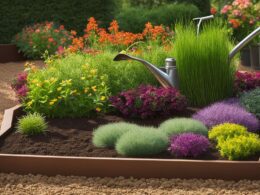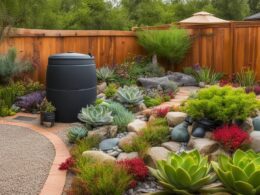If you have dry soils in your garden and are looking for sustainable gardening options, native groundcovers are the perfect solution. These groundcovers not only add beauty to your landscape but also support a healthy ecosystem. Unlike invasive and non-native alternatives, native groundcovers are well-adapted to local climates and require less water and maintenance. Let’s explore some native groundcovers that thrive in dry soils in the United States.
Key Takeaways:
- Native groundcovers are a sustainable choice for dry soils in the US.
- They promote a healthy ecosystem and support wildlife.
- Native groundcovers require less water and maintenance compared to non-native options.
- There are native groundcovers suitable for both shaded and sunny areas with dry soils.
- Choose native groundcovers that are well-suited to the specific growing conditions in your garden.
Benefits of Native Groundcovers
Native groundcovers offer numerous benefits when planted in dry soil environments. These plants not only provide beauty and aesthetics to your garden but also contribute to the overall health and sustainability of the ecosystem. By choosing native groundcovers over invasive or non-native options, you can create a low-maintenance and environmentally-friendly landscape.
One of the key advantages of native groundcovers is their adaptability to local climates and soil conditions. These plants have evolved over time to thrive in specific regions, making them better suited for the dry soils found in certain areas of the United States. As a result, they require less water and maintenance compared to non-native alternatives.
Native groundcovers also contribute to erosion control, preventing soil erosion and promoting stability in your garden. Their dense root systems help bind the soil together, reducing the risk of runoff and soil loss during heavy rains. Additionally, these plants act as natural weed suppressors, minimizing the growth of unwanted plants and reducing the need for herbicides or manual weeding.
Furthermore, native groundcovers provide essential habitat and food sources for wildlife, contributing to the overall biodiversity of your garden. These plants attract and support native pollinators, birds, and beneficial insects, creating a thriving ecosystem that is in balance with nature. By incorporating native groundcovers into your garden, you are actively contributing to the preservation of local flora and fauna.
| Benefits of Native Groundcovers | |
|---|---|
| Adaptability to local climates and soil conditions | Require less water and maintenance |
| Erosion control and soil stability | Natural weed suppressors |
| Habitat and food sources for wildlife | Promote biodiversity |
Native Groundcovers for Part Shade to Shade
In partially shaded to shaded areas with dry soils, there are several native groundcovers that thrive. These native options not only add beauty to your garden but also provide numerous benefits to the ecosystem. Let’s explore some of the native groundcovers that are well-suited for part shade to shade conditions in dry soils:
1. Wild Ginger (Asarum canadense)
Wild ginger is a low-aggressiveness groundcover that grows well in moist shade. It features attractive heart-shaped leaves and is known to attract pipevine swallowtail butterflies. With its deep green foliage, wild ginger adds a touch of elegance to any shaded area.
2. Green and Gold (Chrysogonum virginianum)
Green and gold is another low-aggressiveness groundcover that thrives in part shade to shade conditions. It produces bright yellow flowers that bring a burst of color to your garden. This native groundcover spreads through rhizomes and also provides suitable wildlife cover.
3. Hay-Scented Fern (Dennstaedtia punctilobula)
Hay-scented fern is a high-aggressiveness groundcover that is well-suited for woodlands and shaded areas with dry soils. It forms large colonies, making it an excellent choice for providing wildlife cover and adding texture to your garden.
4. White Wood Aster (Eurybia divaricata)
White wood aster is a high-aggressiveness groundcover that thrives in part shade to shade conditions. It features tall growth and produces delicate white flowers that attract insects. This native groundcover adds vertical interest to your garden and creates a vibrant atmosphere.
By incorporating these native groundcovers into your garden, you can enjoy the beauty of their foliage and flowers while supporting the local ecosystem. These groundcovers not only provide ground cover but also contribute to the overall health of your garden.
| Native Groundcover | Aggressiveness | Growth Conditions | Notable Features |
|---|---|---|---|
| Wild Ginger | Low | Moist Shade | Attracts pipevine swallowtail butterflies |
| Green and Gold | Low | Part Shade to Shade | Bright yellow flowers, spreads through rhizomes |
| Hay-Scented Fern | High | Woodlands, Shade | Forms large colonies, suitable for wildlife cover |
| White Wood Aster | High | Part Shade to Shade | Tall growth, dainty white flowers, attracts insects |
These native groundcovers offer a sustainable and visually appealing solution for dry soils in shaded areas. Consider incorporating them into your garden to create a beautiful and environmentally-friendly landscape.
Native Groundcovers for Sun to Part Shade
In areas with sun to partial shade and dry soils, several native groundcovers can thrive and add beauty to your garden. These groundcovers are well-adapted to the local climate and require less water and maintenance compared to non-native options. Let’s explore some native groundcovers that are suitable for sun to part shade conditions in dry soils.
Wild Strawberry (Fragaria virginiana)
- Low to medium aggressiveness
- Spreads quickly and forms a dense groundcover
- Produces small, edible fruit
- Supports native bees and caterpillars
Golden Ragwort (Packera aurea)
- High aggressiveness
- Evergreen foliage
- Produces long-blooming bright yellow flowers
- Self-sows vigorously
Virginia Creeper (Parthenocissus quinquefolia)
- High aggressiveness
- Rapid growth
- Beautiful foliage that turns red in the fall
- Provides habitat for small critters
Dwarf Cinquefoil (Potentilla canadensis)
- Medium aggressiveness
- Low-growing with a cascading habit
- Attractive foliage
- Tolerates dry soils and sun
These native groundcovers are excellent choices for sunny to partially shaded areas with dry soils. They offer a range of textures, colors, and growth habits to enhance your garden’s aesthetics. Whether you want a low-maintenance groundcover that spreads quickly or a compact option with attractive foliage, there is a native groundcover suited to your needs.
Native Groundcovers for Various Growing Conditions
Native groundcovers are incredibly versatile and can adapt to various growing conditions, even in dry soils. Whether you have a large shady site, a part shade area with medium moisture, or a sunny spot with sandy soil, there are native groundcovers that can thrive in these conditions. By selecting the right groundcovers for your specific growing conditions, you can create a beautiful and sustainable landscape.
Large Shady Sites
If you have a large shady area with dry soil, several native groundcovers are well-suited for these conditions. May-apple, Canada windflower, Eastern hay-scented fern, large-leaved wood-aster are all excellent options. These groundcovers have aggressive growth habits and can quickly fill in large areas, providing dense foliage and suppressing weeds. Their adaptability to shade and dry soils make them ideal choices for large, shady sites.
Part Shade with Medium Moisture
For areas that receive partial shade and have medium moisture levels, there are native groundcovers that can thrive in these conditions. Canada wild ginger, golden star, wild bleeding-heart, and white wood-aster are among the suitable choices. These groundcovers feature dainty flowers and add a touch of elegance to your garden. They can tolerate both shade and moderate moisture, making them perfect for part shade areas with medium moisture.
Moist to Dry Acidic Soils
If you have moist to dry acidic soils, there are native groundcovers that can thrive in these conditions. Bunchberry, wintergreen, large-leaved wood-aster, white wood-aster, and Canada-mayflower are all well-adapted to these soil types. These groundcovers offer a mix of attractive foliage and delicate flowers, adding visual interest to your garden. They can tolerate the acidity of the soil and thrive in moist to dry conditions.
Sun-Loving Groundcovers for Sandy or Gravelly Soil
For sunny areas with sandy or gravelly soil, there are native groundcovers that can handle these conditions. Bearberry, sand/moss phlox, common strawberry, bush-honeysuckle, juniper, and fragrant sumac are all excellent options. These groundcovers are specifically adapted to thrive in full sun and well-drained soils. They offer vibrant foliage, attractive flowers, and create a beautiful ground cover in sunny areas.
Are Native Groundcovers for Dry Soils also Suitable for Xeriscaping in the US?
Yes, the best native plants for xeriscaping are often well-suited for dry soils. Native groundcovers like creeping thyme, ice plant, and blue fescue are excellent options for xeriscaping in the US. These low-maintenance plants require little to no irrigation, making them perfect for dry landscapes.
Conclusion
Native groundcovers are the ideal solution for transforming dry soils into vibrant and sustainable gardens. By choosing these native options, you can create a low-maintenance and environmentally-friendly landscape that thrives in challenging conditions.
Not only do native groundcovers provide beauty and visual appeal, but they also play a crucial role in supporting the local ecosystem. They attract wildlife and promote biodiversity, creating a healthier and more balanced environment for all.
With their adaptability to dry soils, native groundcovers are a key component of sustainable gardening practices. They require less water and maintenance compared to non-native alternatives, reducing your environmental impact while still achieving stunning results.
So, why wait? Explore the wide variety of native groundcovers available and unleash the potential of your dry soil areas. With the right choices, you can create a thriving and visually appealing garden that benefits both you and the natural world.












